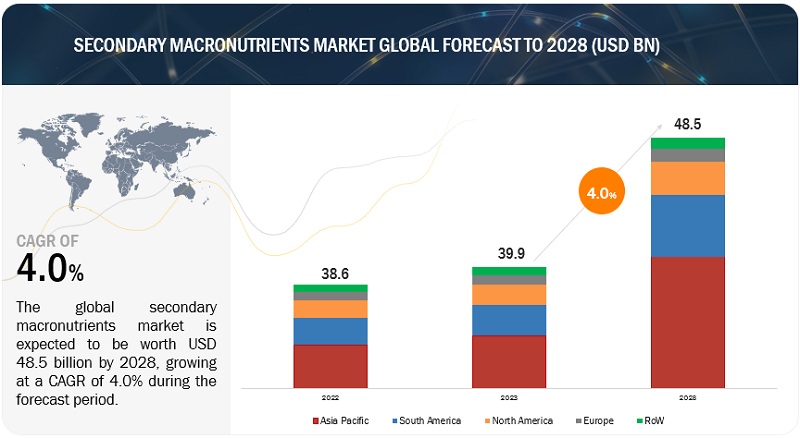
The secondary macronutrients market is expected to be valued USD 39.9 billion in 2023 and USD 48.5 billion by 2028, with a CAGR of 4.0% over the forecast period. Due to the rise in the demand for food such as cereals & grains and fruits & vegetables the global secondary macronutrient market is projected to grow at a robust growth rate. Farmers are becoming more aware of the value of secondary macronutrients in crop production and are turning to these fertilizers to boost yields and quality, is further fueling the growth of the market.
Download PDF brochure: https://www.marketsandmarkets.com/pdfdownloadNew.asp?id=45874881
The consumption of animal products increases as more people enter the middle class, which in turn drives up the demand for grains and other crops to feed the animals. The amount of arable land accessible for farming declines as more people move into urban areas, necessitating an increase in agricultural production on already-existing farmland. To supply the needs of the urban population, it is necessary to boost the productivity of already used agricultural land and to investigate novel approaches to food production, such as vertical farming and urban agriculture. The most effective use of secondary nutrients can significantly boost the productivity of currently used agricultural land and support sustainable and creative methods of food production.
Precision agriculture includes site-specific nutrient management, which may be applied to any field or crop. It is a technology-based technique of growing crops effectively and on-site using specialized application equipment that can maintain water and nutrients in the root zone. Precision farming can enhance output and fertilizer usage efficiency by preventing nutrients from leaching from or accumulating in excessive amounts in specific areas of the field. Precision farming is gaining popularity in industrialized nations because of the efficient use of the fertigation method, which has the potential to be a successful instrument in the judicious delivery of secondary nutrients, resulting in decreased application costs. The kind of secondary nutrient and its formulation may be entered into the information system, which can then offer an accurate analysis of the crop’s nutrient requirements, application rate, and mixing ratio inside the fertigation system.
Liquid spraying methods improve plant response in terms of accuracy and nutrient availability to plants. Liquid fertilizer is applied evenly and precisely to the edge of the field, unlike granular application. One advantage of liquid spraying is that the liquid penetrates the soil more quickly, allowing plants to access nutrients sooner. Some plants will see immediate results from this application. In fact, many growers use this type of fertilizer early in the season to ensure rapid root growth so that the plants can take root when they absolutely need to. Its precision allows farmers to aim their crops more efficiently, and the nutrients are used exactly where plants need them.
Inquiry before buying: https://www.marketsandmarkets.com/Enquiry_Before_BuyingNew.asp?id=45874881
With increasing health awareness across people of different age groups, the demand for fresh foods, fruits & vegetables, is growing rapidly. In developed countries such as US, Canada, UK, Germany, among others, people are adopting veganism which makes fruits & vegetables major source of vitamins and mineral in their diet. Thus, production of these crops is predicted to increase with increased demand. Deficiency of secondary macronutrients can severely affect the yield quality as well as quantity of these crops. For instance, calcium deficiency produces small, thickened leaves and causes loss of vigor, thinning of foliage, and decreased fruit production.
South America is the fastest growing region in the secondary macronutrients market. South America has a large agricultural sector, which is a significant contributor to the region’s economy. The use of secondary macronutrient fertilizers can help farmers improve crop yields and profitability. The availability of secondary macronutrient fertilizers is increasing in the South America region, making it easier and more cost-effective for farmers to use these fertilizers. Many South American countries export agricultural products to other countries, and the use of secondary macronutrient fertilizers can help ensure that these products meet the quality standards required by export markets. and hence it is projected to foster at a higher rate in the secondary macronutrients market.
